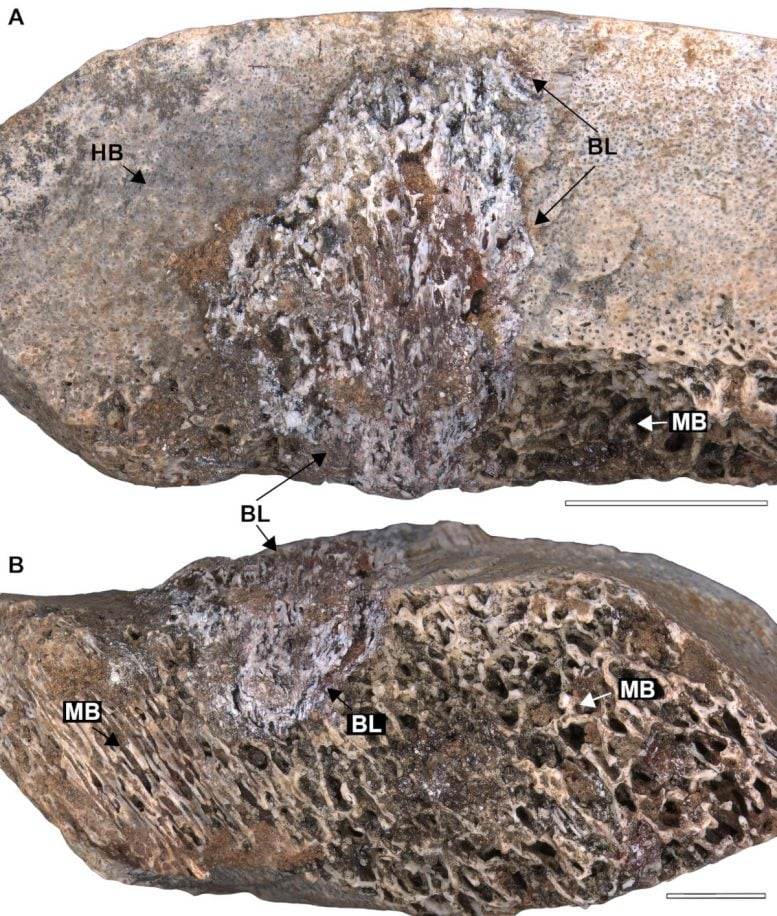Deadly Bone Infections That Struck Brazil’s Sauropod Dinosaurs

Fossil evidence from southeast Brazil has revealed that long-necked sauropod dinosaurs, living around 80 million years ago, suffered from a painful and deadly bone disease known as osteomyelitis.
This infection left distinct marks in their fossilized bones and may have played a major role in wiping out many of these giants. The study, recently published in The Anatomical Record, examined multiple specimens from the Ibirá locality in São Paulo state, part of the Bauru Group (specifically the São José do Rio Preto Formation).
The Fossil Evidence
Researchers analyzed the fossilized remains of at least six sauropod individuals, all recovered from the same paleontological site. These bones showed unmistakable signs of osteomyelitis, a condition where bone tissue becomes infected or inflamed.
What makes these fossils especially significant is that the lesions showed no signs of healing. Usually, when animals suffer bone injuries or infections, the body attempts to repair the damage, often leaving behind evidence of new bone growth. However, in these Brazilian fossils, such healing was absent. This strongly suggests that the animals died while still suffering from the disease, pointing to its deadly nature.
What is Osteomyelitis?
Osteomyelitis is an infection that affects bone tissue. In modern animals, it is most commonly caused by bacteria, but viruses, fungi, or even protozoa can also trigger it. The infection usually spreads through the bloodstream or from nearby tissue, and it leaves clear damage that can often be identified even millions of years later in fossilized remains.
In these sauropods, researchers observed three distinct forms of osteomyelitis, previously unknown in dinosaur paleopathology:
- Circular protrusions or bumps that appeared on the bone surface.
- Elliptical protrusions with a pattern resembling fingerprints.
- Large round lesions, much wider and deeper than the others.
Some lesions were confined to the bone marrow, while others extended outward, giving the bone surface a spongy texture associated with new blood vessel growth. This pattern distinguishes the condition from other diseases such as osteosarcoma (a form of bone cancer) or other neoplasias.
The Environment That Helped Spread the Disease
The region where these fossils were found had an arid climate during the Late Cretaceous. Shallow rivers and large pools of standing water were common, and many animals—dinosaurs, turtles, and crocodile-like reptiles—would have relied on them.
Such environments are ideal breeding grounds for pathogens. Researchers suggest that infections could have been spread through mosquitoes or directly from contaminated drinking water. Since all the diseased fossils come from the same site and date to roughly the same time period, it is likely that the environment created the perfect conditions for an epidemic to spread among sauropods.
Why the Lack of Healing Matters
One of the most striking findings is the absence of healing in all examined bones. Normally, fossils with injuries from predators or accidents show evidence of bone regeneration. For example, bite marks from carnivorous dinosaurs often healed if the animal survived the attack.
In contrast, these sauropod bones showed no regeneration at all. This means the animals were still fighting the infection when they died. The disease seems to have been relentlessly fatal, with no recovery in any of the cases studied.
Advanced Techniques Used in the Study
To identify the lesions in detail, the research team employed both stereomicroscopy and scanning electron microscopy (SEM). These advanced tools allowed them to closely examine the structure of the affected bones.
They discovered microscopic details that confirmed the diagnosis of osteomyelitis and revealed the unique morphologies of the three new lesion types. The fine-grained analysis is what enabled the team to rule out cancer and other causes of bone damage.
Connections to Earlier Discoveries
This was not the first time osteomyelitis was found in dinosaurs from Brazil. In 2021, a smaller titanosaur species called Ibirania parva, also from the same region, was shown to have suffered from a similar infection. That study suggested the disease might have been linked to blood parasites.
The new research builds on that earlier finding but expands it dramatically. Instead of one individual, we now know of multiple cases affecting both small and large sauropods. This indicates that bone infections were widespread, not isolated, and that the environment may have facilitated repeated outbreaks.
Why This Discovery Matters
Finding evidence of infectious disease in the fossil record is extremely rare. Pathological studies of dinosaurs more often reveal injuries (like fractures or bite marks) rather than infections.
This discovery adds a valuable dimension to our understanding of dinosaur health. It shows that disease, not just predators, climate change, or volcanic activity, could have posed a serious survival challenge for these massive creatures.
It also broadens the field of paleopathology, giving researchers new criteria to distinguish between different types of bone damage in fossils. The recognition of multiple osteomyelitis forms is a step toward building a clearer picture of how diseases affected ancient ecosystems.
Sauropods of Brazil
The sauropods of Brazil, including species like Tambatitanis and Ibirania, lived during the Late Cretaceous and were part of a diverse dinosaur community in South America. These long-necked herbivores are famous for their enormous size, with some species reaching dozens of meters in length.
The discovery of osteomyelitis in multiple individuals shows that even these giants were not immune to microscopic threats. Despite their size and strength, diseases could have had a devastating effect, much like in modern animal populations.
How Diseases Shape Ecosystems
This finding raises broader questions about the role of disease in prehistoric ecosystems. Just as outbreaks of illness can alter wildlife populations today, it is possible that infections influenced dinosaur populations in subtle but significant ways.
For example, recurring bone infections may have weakened sauropod herds, making them more vulnerable to predators or environmental stress. In extreme cases, outbreaks could have reduced population numbers and contributed to local extinctions.
Lessons for Modern Science
Although the infected dinosaurs lived millions of years ago, their fossils provide insights that can still be relevant today. They demonstrate how environmental conditions—such as stagnant water and high parasite loads—can promote the spread of deadly diseases.
Modern ecosystems face similar challenges, particularly in tropical and subtropical regions where mosquito-borne diseases affect both humans and animals. Understanding how ancient species were affected by disease gives us a long-term perspective on the interactions between pathogens, hosts, and environments.
Summary of the Findings
- Location: Ibirá, São Paulo, Brazil (Bauru Group, São José do Rio Preto Formation).
- Time period: About 80 million years ago (Late Cretaceous).
- Specimens: Six sauropod individuals.
- Condition: Osteomyelitis (bone infection).
- Lesion types: Three new forms – circular bumps, fingerprint-like protrusions, and large round lesions.
- Microscopy used: SEM and stereomicroscopy.
- Healing evidence: None – all individuals died while still infected.
- Cause of spread: Likely waterborne pathogens or insect vectors like mosquitoes.
- Earlier connection: 2021 study on Ibirania parva with similar infection.
- Significance: Shows that infectious disease was a major threat to dinosaur populations and provides new criteria for paleopathology research.
Final Thoughts
The discovery of widespread osteomyelitis in Brazilian sauropods opens an important window into the hidden health struggles of dinosaurs. These giant creatures, often imagined as invincible, were in fact vulnerable to the same kind of microbial threats that still affect life today.
By uncovering and describing these diseases in detail, paleontologists are not only piecing together the story of ancient life but also offering insights into how disease has always been a powerful force in shaping ecosystems.
Research Reference: Several occurrences of osteomyelitis in dinosaurs from a site in the Bauru Group, Cretaceous of Southeast Brazil – The Anatomical Record, 2025





